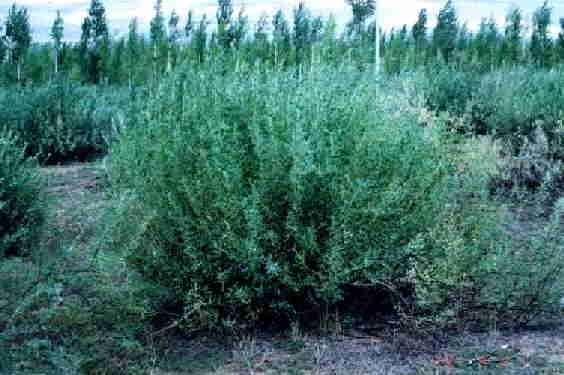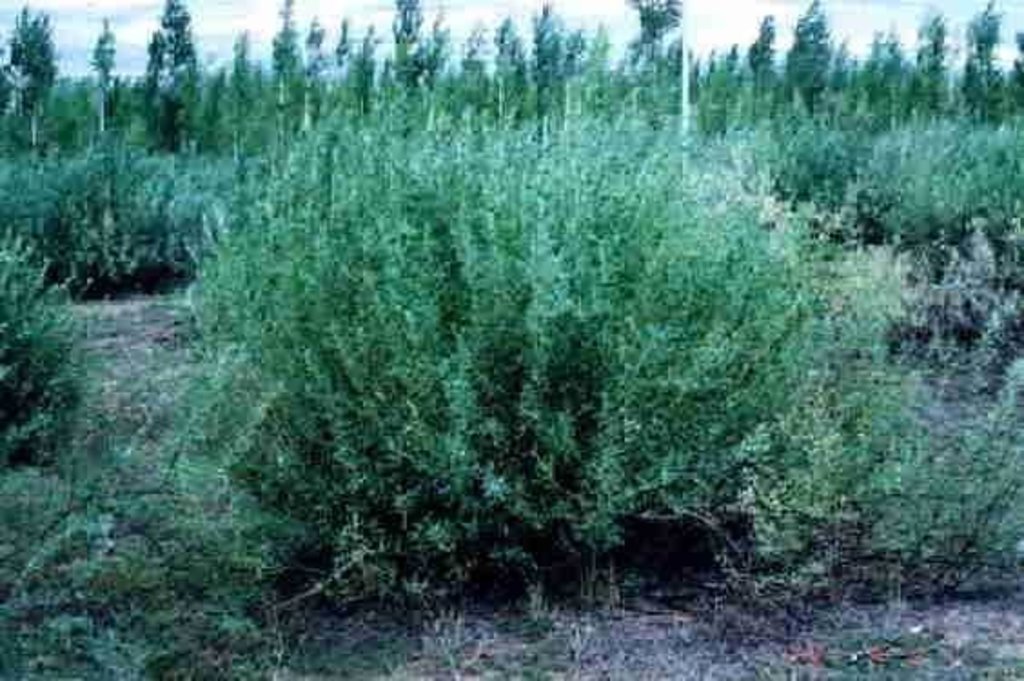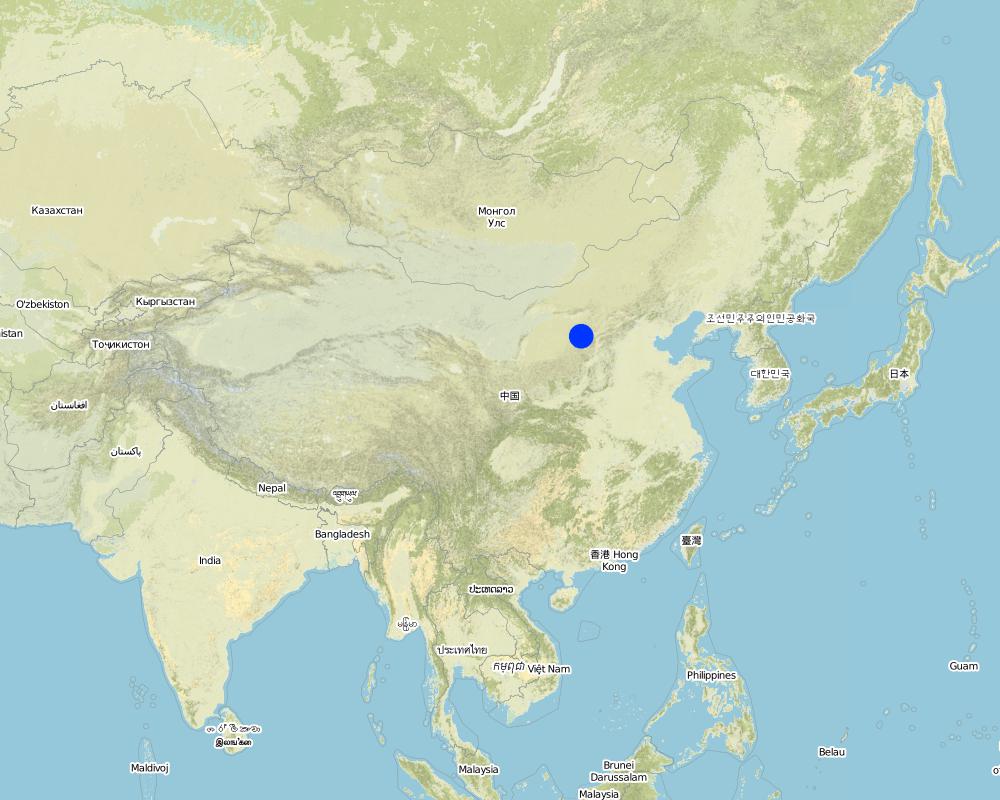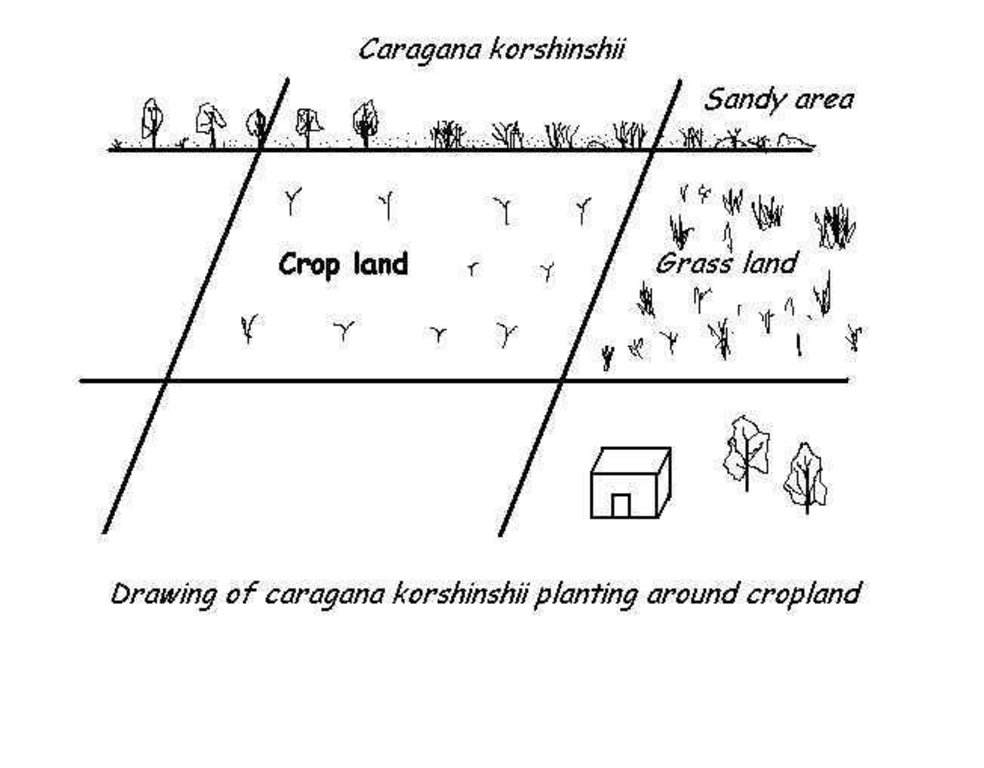Caragana Korshinskii Planting a kind of SWC vegetative technology [China]
- Creation:
- Update:
- Compiler: Jinsheng FU
- Editor: –
- Reviewers: David Streiff, Alexandra Gavilano
Ning Tiao Planting
technologies_1370 - China
View sections
Expand all Collapse all1. General information
1.2 Contact details of resource persons and institutions involved in the assessment and documentation of the Technology
Name of the institution(s) which facilitated the documentation/ evaluation of the Technology (if relevant)
Department of Resources and Environmental Science, Beijing Normal University (Department of Resources and Environmental Science, Beijing Normal University) - China1.3 Conditions regarding the use of data documented through WOCAT
The compiler and key resource person(s) accept the conditions regarding the use of data documented through WOCAT:
Yes
1.5 Reference to Questionnaire(s) on SLM Approaches (documented using WOCAT)
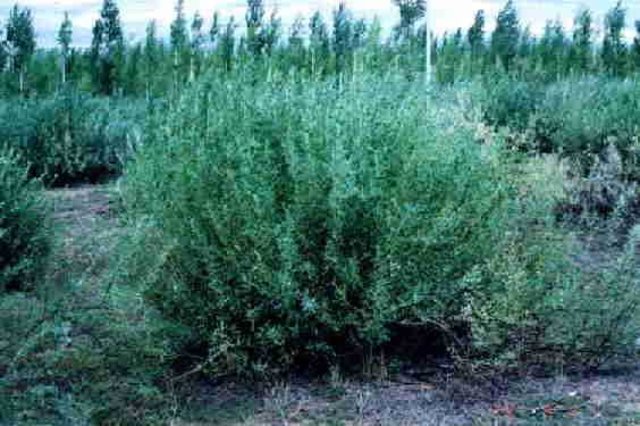
Caragana Korshinskii Planting - a SWC vegetation technology [China]
SWC decision makers, I.e. approach planners, lead local people to plant caragana korshinskii in the areas of serious water and/or wind erosion by means of combined inputs from government, locals and social loan etc.
- Compiler: Jinsheng FU
2. Description of the SLM Technology
2.1 Short description of the Technology
Definition of the Technology:
Caragana korshinskii, a kind of perennial shrub, is used to protect soil from water and wind erosion, rhizobium in its root can increase soil fertility.
2.2 Detailed description of the Technology
Description:
Caragana korshinskii is a kind of perennial and drought resistant shrub being used to protect soil from water and wind erosion. It has long roots in and can extract water from deep soil layers. Its roots with rhizobium can improve soil fertility. So caragana korshinskii can be planted where water and /or wind erosion is serious. Its branch has economic value. In autumn before raining, caragana korshinskii seeds are planted into holes. In the first three or four years, It should be protected from cutting and sheep eating. From the fourth year its branches are cut as fodder or fuel or to make paper, its seeds are collected for sale, flowers are used to breed bees, and so on.
2.3 Photos of the Technology
2.5 Country/ region/ locations where the Technology has been applied and which are covered by this assessment
Country:
China
Region/ State/ Province:
Shanxi
Specify the spread of the Technology:
- evenly spread over an area
If the Technology is evenly spread over an area, specify area covered (in km2):
8362.4
If precise area is not known, indicate approximate area covered:
- 1,000-10,000 km2
Comments:
Total area covered by the SLM Technology is 8362.4 km2.
Caragana korshinskii is one of most drought endurable shrubs. Once planted, it grows very fast.
Map
×2.6 Date of implementation
If precise year is not known, indicate approximate date:
- less than 10 years ago (recently)
2.7 Introduction of the Technology
Specify how the Technology was introduced:
- through land users' innovation
Comments (type of project, etc.):
Indigenous.
3. Classification of the SLM Technology
3.1 Main purpose(s) of the Technology
- reduce, prevent, restore land degradation
3.2 Current land use type(s) where the Technology is applied
Land use mixed within the same land unit:
Yes
Specify mixed land use (crops/ grazing/ trees):
- Agro-pastoralism (incl. integrated crop-livestock)

Cropland
- Annual cropping
- Perennial (non-woody) cropping
Annual cropping - Specify crops:
- cereals - maize
- root/tuber crops - potatoes
- vegetables - leafy vegetables (salads, cabbage, spinach, other)
- wheat
- Caragana korshinskii
Number of growing seasons per year:
- 2
Specify:
Longest growing period in days: 160Longest growing period from month to month: Apr - Sep

Grazing land
Comments:
Major land use problems (compiler’s opinion): Serious water and/or wind erosion, poor economic development and lack of SWC knowledge.
Major land use problems (land users’ perception): Combined wind and water erosion, low crop yield, inadequate humus in soils, steep slope land.
3.4 Water supply
Water supply for the land on which the Technology is applied:
- mixed rainfed-irrigated
Comments:
Water supply also rainfed
3.5 SLM group to which the Technology belongs
- windbreak/ shelterbelt
- integrated soil fertility management
3.6 SLM measures comprising the Technology

vegetative measures
- V1: Tree and shrub cover
3.7 Main types of land degradation addressed by the Technology

soil erosion by water
- Wt: loss of topsoil/ surface erosion
- Wg: gully erosion/ gullying

soil erosion by wind
- Et: loss of topsoil

chemical soil deterioration
- Cn: fertility decline and reduced organic matter content (not caused by erosion)

water degradation
- Ha: aridification
Comments:
Main type of degradation addressed: Wt: loss of topsoil / surface erosion, Wg: gully erosion / gullying, Et: loss of topsoil, Cn: fertility decline and reduced organic matter content, Ha: aridification
Main causes of degradation: deforestation / removal of natural vegetation (incl. forest fires), over-exploitation of vegetation for domestic use, overgrazing, other human induced causes (specify) (Agricultural causes), land tenure (Land subdivision), poverty / wealth (Lack of captial), education, access to knowledge and support services (Lack of knowledge)
Secondary causes of degradation: labour availability (Lack of labour), Lack of enforcement of legislat./authority
3.8 Prevention, reduction, or restoration of land degradation
Specify the goal of the Technology with regard to land degradation:
- adapt to land degradation
4. Technical specifications, implementation activities, inputs, and costs
4.1 Technical drawing of the Technology
Technical specifications (related to technical drawing):
Drawing of caragana korshinskii applied in the north of the Loess Plateau.
Location: Pianguan. Shanxi
Date: 2002
Technical knowledge required for field staff / advisors: high
Technical knowledge required for land users: moderate
Main technical functions: control of raindrop splash, control of dispersed runoff: retain / trap, control of dispersed runoff: impede / retard, control of concentrated runoff: retain / trap, control of concentrated runoff: impede / retard, reduction of slope angle, reduction of slope length, improvement of ground cover, increase of surface roughness, increase in organic matter, increase of infiltration, increase / maintain water stored in soil, water harvesting / increase water supply, water spreading, reduction in wind speed, improvement of soil structure, increase in soil fertility
Trees/ shrubs species: Caragana korshinskii
Slope (which determines the spacing indicated above): 32.00%
If the original slope has changed as a result of the Technology, the slope today is (see figure below): 25.00%
Gradient along the rows / strips: 20.00%
Author:
BAI Zhanguo, Beijing China
4.2 General information regarding the calculation of inputs and costs
Specify currency used for cost calculations:
- USD
Indicate average wage cost of hired labour per day:
5.00
4.3 Establishment activities
| Activity | Timing (season) | |
|---|---|---|
| 1. | collecting seeds | July to August |
| 2. | digging holes | before raining in Autumn |
| 3. | seeding | before raining in Autumn |
| 4. | watering |
4.4 Costs and inputs needed for establishment
Comments:
Duration of establishment phase: 36 month(s)
4.5 Maintenance/ recurrent activities
| Activity | Timing/ frequency | |
|---|---|---|
| 1. | protecting young plants from sheep | In the first three years |
| 2. | cutting of branches | after four years /According to utilization |
| 3. | protecting young from insects | from florescence /annual |
4.6 Costs and inputs needed for maintenance/ recurrent activities (per year)
Comments:
planting density, slope gradient and length, SWC area.
4.7 Most important factors affecting the costs
Describe the most determinate factors affecting the costs:
manual labor, maintenance of young plants in the first 3-4 years.
5. Natural and human environment
5.1 Climate
Annual rainfall
- < 250 mm
- 251-500 mm
- 501-750 mm
- 751-1,000 mm
- 1,001-1,500 mm
- 1,501-2,000 mm
- 2,001-3,000 mm
- 3,001-4,000 mm
- > 4,000 mm
Specifications/ comments on rainfall:
350~550mm in loess plateau mainly from June to September
Agro-climatic zone
- sub-humid
- semi-arid
5.2 Topography
Slopes on average:
- flat (0-2%)
- gentle (3-5%)
- moderate (6-10%)
- rolling (11-15%)
- hilly (16-30%)
- steep (31-60%)
- very steep (>60%)
Landforms:
- plateau/plains
- ridges
- mountain slopes
- hill slopes
- footslopes
- valley floors
Altitudinal zone:
- 0-100 m a.s.l.
- 101-500 m a.s.l.
- 501-1,000 m a.s.l.
- 1,001-1,500 m a.s.l.
- 1,501-2,000 m a.s.l.
- 2,001-2,500 m a.s.l.
- 2,501-3,000 m a.s.l.
- 3,001-4,000 m a.s.l.
- > 4,000 m a.s.l.
Indicate if the Technology is specifically applied in:
- not relevant
Comments and further specifications on topography:
Landforms also hill slopes
5.3 Soils
Soil depth on average:
- very shallow (0-20 cm)
- shallow (21-50 cm)
- moderately deep (51-80 cm)
- deep (81-120 cm)
- very deep (> 120 cm)
Soil texture (topsoil):
- coarse/ light (sandy)
- medium (loamy, silty)
Topsoil organic matter:
- low (<1%)
If available, attach full soil description or specify the available information, e.g. soil type, soil PH/ acidity, Cation Exchange Capacity, nitrogen, salinity etc.
Soil fertility: low - medium
Soil drainage / infiltration: good
Soil water storage capacity: low
5.6 Characteristics of land users applying the Technology
Off-farm income:
- 10-50% of all income
Relative level of wealth:
- average
Level of mechanization:
- manual work
- animal traction
Indicate other relevant characteristics of the land users:
Population density: 100-200 persons/km2
Annual population growth: < 0.5%
20% of the land users are very rich (>1000).
14% of the land users are rich (800~1000).
49% of the land users are average wealthy (400~800).
14% of the land users are poor (200~400).
3% of the land users are poor (<200).
Off-farm income specification: The land users who applied the SWC technology can feed much more cattle, sheep and goat etc than those who do not take the SWC measure.
5.8 Land ownership, land use rights, and water use rights
Land ownership:
- state
Land use rights:
- communal (organized)
- individual
6. Impacts and concluding statements
6.1 On-site impacts the Technology has shown
Ecological impacts
Water cycle/ runoff
surface runoff
Quantity before SLM:
10
Quantity after SLM:
2
Soil
soil loss
Quantity before SLM:
170
Quantity after SLM:
75
6.4 Cost-benefit analysis
How do the benefits compare with the establishment costs (from land users’ perspective)?
Short-term returns:
slightly negative
Long-term returns:
very positive
How do the benefits compare with the maintenance/ recurrent costs (from land users' perspective)?
Short-term returns:
slightly negative
Long-term returns:
very positive
6.5 Adoption of the Technology
- > 50%
If available, quantify (no. of households and/ or area covered):
167250 households
Of all those who have adopted the Technology, how many did so spontaneously, i.e. without receiving any material incentives/ payments?
- 0-10%
Comments:
100% of land user families have adopted the Technology with external material support
167250 land user families have adopted the Technology with external material support
Comments on acceptance with external material support: estimates
Comments on spontaneous adoption: estimates
There is a moderate trend towards spontaneous adoption of the Technology
Comments on adoption trend: More and more people become to know the importance of protection environment. More and more people get to recognize the economic value of planting caragana korshinskii.
7. References and links
7.1 Methods/ sources of information
7.2 References to available publications
Title, author, year, ISBN:
Li Jinchuan, Wang Wenying, Lu Chongen. Exploration on Restoring Vegetations of Dump Land on An-Tai-Bao Surface Mine.. 1999.
Available from where? Costs?
Henan Science.17(Suppl.): 92-95.
Title, author, year, ISBN:
Bai Yongqiang. Studies on Phenological Patterns of the Main Shrubs in Yanchi Sandy Land.. 1998.
Available from where? Costs?
Journal of Arid land Resources and Environment. 12(2): 82-86.
Title, author, year, ISBN:
Yang Wenbin, Ren Jianmin, Jia Cuiping. Studies of The Relationship Between Physiological Ecology of Drought-Resist in Caragana Korshinskii and Soil Water.. 1997.
Available from where? Costs?
Acta Ecologica Sinica. 17(3): 239-244.
Title, author, year, ISBN:
u Xuewen. Visible benefits of developing Caragana korshinskii in Pianguan county.. 1987.
Available from where? Costs?
Economic benefits corpus of soil and water conservation, 10: 43-44.
Title, author, year, ISBN:
Li Zhirong. To advocate for Caragana korshinskii.. 1987.
Available from where? Costs?
Economic benefits corpus of soil and water conservation. 10: 36-38.
Title, author, year, ISBN:
Zhao Zhizhong. Planting Caragana korshinskii extensively, breeding livestock to reach richness.. 1997.
Available from where? Costs?
oil and Water Conservation Science and Technology in Shanxi..3: 26-28.
Title, author, year, ISBN:
Niu Xiwu. The distribution and description of Caragana Fabr. In China.. 1999.
Available from where? Costs?
Acta Bot. Boreal. Accident Sin. 19(5): 107-133.
Title, author, year, ISBN:
Pan Ming, Zhao Jinrong. Benefits of Caragana korshinskii and its planting technology.. 1987.
Available from where? Costs?
Economic benefits corpus of soil and water conservation. 10:39-42.
Title, author, year, ISBN:
Cheng Jimin. The Reasonable Utilization and Patterns of the Main Shrub Species In Southern Ningxia Hui Autonomous Region.. 1991.
Available from where? Costs?
Bulletin of Soil and Water Conservation. 11(1): 54-61.
Title, author, year, ISBN:
Li Zizhen, Huan Zitan, Zhang Liping. Comprehensive Judgment of Sandfixing Benefits of Plants in the Ecological engineering of Sand Management.. 1997.
Available from where? Costs?
Journal of Lanzhou Univ.(Social Science). 25(4): 40-47.
Links and modules
Expand all Collapse allLinks

Caragana Korshinskii Planting - a SWC vegetation technology [China]
SWC decision makers, I.e. approach planners, lead local people to plant caragana korshinskii in the areas of serious water and/or wind erosion by means of combined inputs from government, locals and social loan etc.
- Compiler: Jinsheng FU
Modules
No modules


